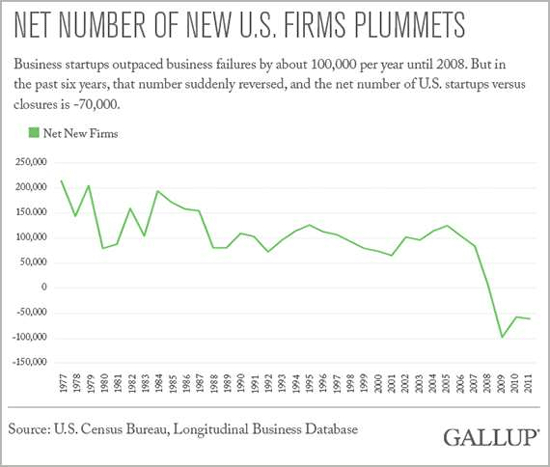Connecting the Dots: The Single Most Important Economic Statistic that the White House Never Talks A
- Shannon Staton
- |
- January 20, 2015
- |
- Comments
For the first time in 35 years, American business deaths now outnumber business births. —Jim Clifton, CEO, Gallup Polls
I’ve been self-employed since 1998, and let me tell you, the life of a business owner isn’t easy. It’s filled with long hours, a relentless amount of paperwork, and uncertainty of where your next paycheck will come from. If you’ve ever owned a business, you know exactly what I’m talking about.
Difficult or not, self-employment is extremely rewarding, and I wouldn’t have it any other way. Nor would the other 6 million business owners in the United States. Of those 6 million businesses, the vast majority are small “Mom and Pop” businesses. Here are more statistics on businesses in the US:
- 3.8 million have four or fewer employees. That’s me!
- 1 million with 5-9 employees;
- 600,000 with 10-19 employees;
- 500,000 with 20-99 employees;
- 90,000 with 100-499 employees;
- 18,000 with 500 employees or more; and
- 1,000 companies with 10,000 employees or more.
Those small businesses are the backbone of our economy and responsible for employing roughly half of all Americans. Moreover, while estimates vary, small business create roughly two-thirds of all new jobs in our country.
For those reasons, the health (or lack thereof) of small business is the single most important long-term indicator of America’s economic health. Warning: new data suggest that small businesses are in deep trouble.
For the first time in 35 years, the number of business deaths outnumbers the number of business births.
The US Census Bureau reported that the birth and death rates of American businesses crossed for the first time ever! 400,000 new businesses were born last year, but 470,000 died.
Yup, business deaths now outnumber business births.
Pay attention, because this part is important.
The problem isn’t so much that businesses are failing, but that American entrepreneurs are simply not starting as many new businesses as they used to.
We like to think of America has the hotbed of capitalism, but the US actually is number 12 among developed nations for new business startups.
Number 12!
You know what countries are ahead of us? Hungary, Denmark, Finland, New Zealand, Sweden, Israel, and even financially troubled Italy are creating new businesses faster than us!
The reasons for the capitalist pessimism are many, but my guess is that the root of the problem comes down to three issues: (1) difficulty of accessing capital (loans); (2) excessive and burdensome government regulations; and (3) an overall malaise about our economic future.
Business owners are permanently smitten with an entrepreneurial bug, and the only thing that prevents them from seeking business success is the expectation that they’ll lose money.
Sadly, the lack of new business startups is confirmation that American’s free enterprise system is broken.
| "There is nobody in this country who got rich on their own. Nobody. You built a factory out there—good for you. But I want to be clear. You moved your goods to market on roads the rest of us paid for. You hired workers the rest of us paid to educate. You were safe in your factory because of police forces and fire forces that the rest of us paid for. You didn't have to worry that marauding bands would come and seize everything at your factory... Now look. You built a factory and it turned into something terrific or a great idea—God bless! Keep a hunk of it. But part of the underlying social contract is you take a hunk of that and pay forward for the next kid who comes along." |
“When small and medium-sized businesses are dying faster than they’re being born, so is free enterprise. And when free enterprise dies, America dies with it,” warns Gallup CEO Jim Clifton.
I don’t believe for a second that America’s free-enterprise system is permanently broken. The pendulum will eventually swing the other way, but our economy will not enjoy boom times until the birth/death trends are reversed.
That won’t happen next week or next month. It will take serious, fundamental changes in tax, regulatory, and judicial rules, and I sadly fear that it will take several years for that to happen.
Until then, our economy is going to struggle and will pull our high-flying stock market down with it. Are you prepared?
If you’re not familiar with inverse ETFs, you’re ignoring one of your best defenses against tough times. An inverse ETF is an exchange-traded fund that’s designed to perform as the inverse of whatever index or benchmark it’s designed to track.
By providing performance opposite to their benchmark, inverse ETFs prosper when stock prices are falling. An inverse S&P 500 ETF, for example, seeks a daily percentage movement opposite that of the S&P. If the S&P 500 rises by 1%, the inverse ETF is designed to fall by 1%; and if the S&P falls by 1%, the inverse ETF should rise by 1%.
There are inverse ETFs for most major indices and even sectors and commodities (like oil and gold), as well as specialty ETFs for things like the VIX Volatility Index.
I’m not suggesting that you rush out and buy a bunch of inverse ETFs tomorrow morning. As always, timing is critical, so I recommend that you wait for my buy signals in my Rational Bear service.
But make no mistake, the birth/death ratio is signaling serious trouble ahead. Any investor who doesn’t prepare for it is going to get run over and flattened like a pancake.

Tony Sagami
30-year market expert Tony Sagami leads the Yield Shark and Rational Bear advisories at Mauldin Economics. To learn more about Yield Shark and how it helps you maximize dividend income, click here. To learn more about Rational Bear and how you can use it to benefit from falling stocks and sectors, click here.



